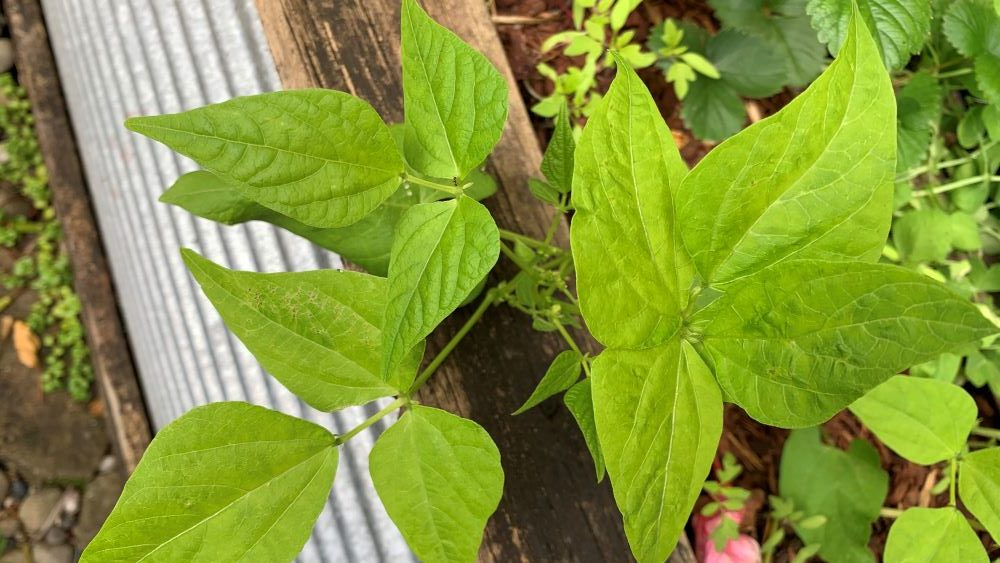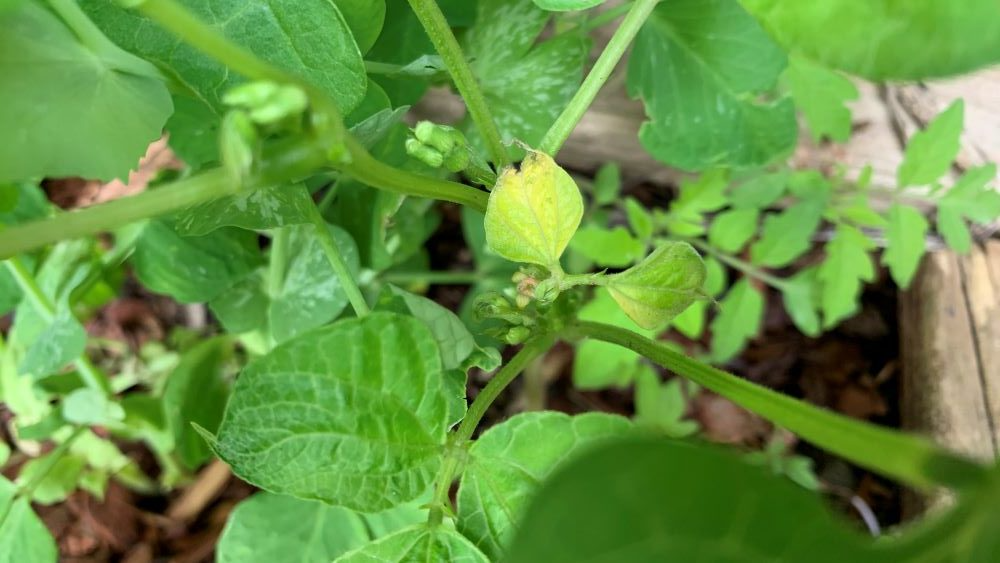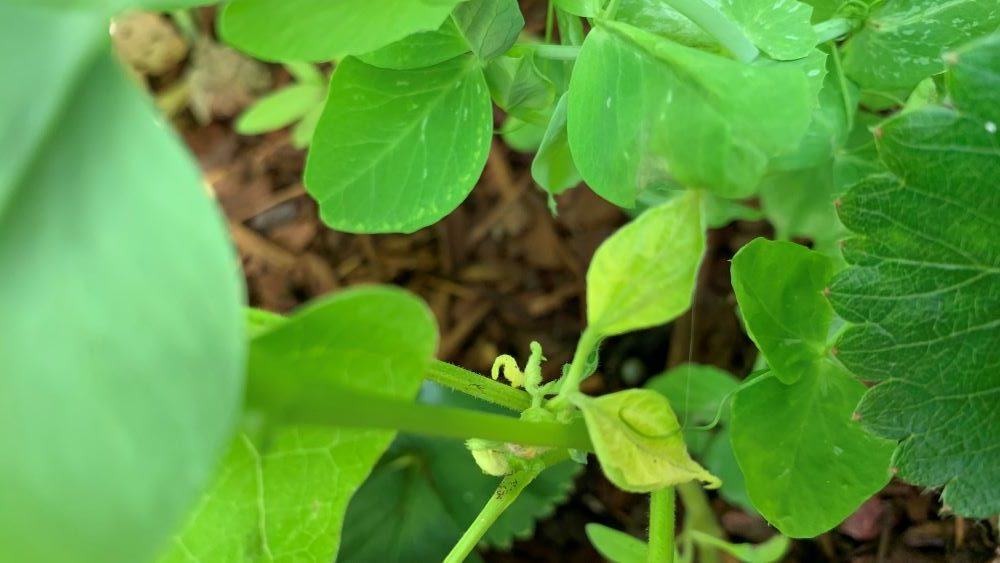Bean leaves will turn yellow if they are getting too much water which can compact the soil and cause root rot. Very poor soils, a lack of sunlight, pest attack, fungus and disease can cause yellow leaves on bean plants. Cure yellow bean leaves with a slow release organic fertilizer like pelleted chicken manure, slow down your watering schedule and give them more sunlight.
This article will explore why bean leaves turn yellow and how to solve each problem.

Top 7 Reasons Why Bean Leaves Turn Yellow
Here are the top 7 common reasons why bean leaves turn yellow and how you can solve each one.
1. Overwatering
The top cause of yellow leaves on bean plants is overwatering. Too much water in the soil can deplete the soil of oxygen, compact the soil and cause fungal root rot. The leaves on the bean plant will start to turn yellow as they no longer are able to absorb the nutrients, oxygen and water they need.

Solution
Reduce the amount of water you are adding to your bean plant and water every few days. If you live in a tropical or sub-tropical climate, bean plants can survive well on rainfall alone.
Add a 2 inch layer of straw mulch under your bean plants to help to regulate the amount of water that reaches the roots. Mulch can also help to reduce soil run off during heavy rainfall and can reduce soil compaction.

3. Not enough light
Bean leaves that do not get enough light will turn yellow over time. Bean plants need light to photosynthesize. The green chlorophyll in the leaves turns light and carbon dioxide into food for the plant. Without sunlight the leaves will turn from green to yellow and eventually the plant will die.
Solution
Move indoor bean leaves out into the bright light when frosts have passed to fix yellow leaf problems from lack of sunlight. Plant bean leaves out into a sunny spot in your garden to encourage them to grow strong, healthy green leaves full of chlorophyll. This helps the plant to develop sugars which go into making the stem structures and leaves.
2. Lack of nutrients
Bean leaves that do not have enough nutrients, including nitrogen, magnesium and iron will turn yellow. It is rare for green beans to lack nitrogen because they can draw nitrogen from the atmosphere and capture it in nodes on their roots.
In very sandy soils or heavy clay however they can struggle to get the other micronutrients they need and develop yellow leaves.https://youtu.be/S7CCp8AwDoI
Solution
Give your beans a quick feed of gentle all-purpose organic liquid fertilizer like fish emulsion to replace the nutrients lost quickly. Follow this up with a handful of pelleted chicken manure which will slowly feed the plant over time.
Nutrient deficiencies are rare for bean plants which can survive in most soils. If you have very sandy soil or heavy clay, adding compost before planting can help the plants to access the nutrients they need.
4. Young leaves
Bean leaves will grow two leaves first that are called cotyledons. They will quickly grow a larger set of second and third leaves. The smaller leaves will turn yellow gradually over time as the larger leaves take over and start to photosynthesize.
This is a completely natural process and it won’t affect the plant growth. Over time the smaller yellow leaves can die off. You can pinch them off to neaten your bean plants or leave them there and they will eventually drop off.
5. Old leaves
Older leaves that grow closer to the base of the bean plant can start to yellow over time. Often the bottom leaves will be shaded, and will just gradually die back. As long as the bean stem is still looking green then there is no problem.
Beans will start to grow new fresh, healthy leaves from the end of their vines. Beans will grow along the stem over time. Dwarf, bushy beans will branch out and grow multiple stems from one growth point. Pinching off any yellowing leaves is a great way to allow more sunlight to reach the healthy leaves.

6. Disease and fungus
Bean plants can be affected by a range of diseases and fungal growth. If you notice any black marks or spots, or fuzzy gray growth then you may have a fungus problem. This can happen when the weather is particularly wet, if there is low air movement around the leaves or if water is splashing soil up onto the leaves.
To prevent fungal growth it is best to surround the beans with mulch to keep the soil off the leaves when watering. Water at the root zone of the plant and try to let the rain do most of the watering for you.
Fungus can be treated with copper fungicides but I prefer to pinch off any damaged and affected leaves so it doesn’t spread. Plant plenty of bean seeds so you can remove any plants that are damaged.
Diseases like blight and rust can also cause yellowing of the leaves. These diseases are caused by fungi and can spread quickly if not treated promptly. If you notice any signs of disease on your green bean plants, it’s important to take action quickly to prevent the spread of the disease.
Mosaic Virus
Mosaic virus is a common viral disease that can infect green beans. The virus causes mosaic-like patterns on the leaves of the plant, which can turn yellow and eventually die. This virus is spread through contact with infected plants or soil, so it is important to practice good sanitation in your garden. If you suspect that your green beans have mosaic virus, you should remove the infected plants immediately to prevent the virus from spreading to other plants.
Bacterial Blight
Bacterial blight is a bacterial disease that can cause yellowing of the leaves on green bean plants. This disease is spread through water, so it is important to avoid overhead watering and to water the plants at the base. If you suspect that your green beans have bacterial blight, you should remove the infected plants immediately to prevent the disease from spreading to other plants.
Fungal Diseases
Fungal diseases can also cause yellowing of the leaves on green bean plants. One common fungal disease is rust, which can cause yellow spots on the leaves. Another fungal disease is powdery mildew, which can cause a white powdery substance to form on the leaves. To prevent fungal diseases, it is important to water the plants at the base and to avoid overhead watering. You should also remove any infected plants immediately to prevent the disease from spreading to other plants.
By identifying the specific issue causing your green bean leaves to turn yellow, you can take the appropriate steps to prevent the spread of the disease and save your plants.
7. Pest attack
Look out for leaves that have had bites taken out of them by passing snails, slugs and caterpillars. You may notice the leaves have holes chewed in them or there are chew marks on the edges.
Other pests such as aphids, thrips and scale are sap sucking and can often be found on the underside of the leaf or on the stems. They will suck the sap from the leave eventually causing it to turn yellow.
Treat sap sucking insects with neem oil by spraying it with a dilute amount every week until the bugs are gone. Neem oil is a natural substance that is an extract of the neem tree.
Check out this quick video that covers the basics of growing bush beans.https://youtu.be/l3NS09izxYE
How to stop bean leaves from turning yellow
Yellowing of green bean leaves is a common problem that can be prevented by taking some simple steps. By following the preventive measures listed below, you can keep your green bean plants healthy and green.
Soil Management
Yellowing of green bean leaves can be caused by nutrient deficiencies or excesses in the soil. Therefore, it is important to maintain the soil’s nutrient balance. You can do this by adding organic matter to the soil, such as compost or well-rotted manure. This helps to improve soil structure and fertility.
It is also important to ensure that the soil pH is within the optimal range for green beans, which is between 6.0 and 6.5. You can use a soil pH test kit to determine the pH of your soil. If the pH is too high or too low, you can adjust it by adding lime (to increase the pH) or sulfur (to decrease the pH).
Proper Watering Techniques
Green beans require consistent moisture to grow and produce healthy foliage. However, overwatering or underwatering can cause yellowing of the leaves. Therefore, it is important to water your green beans properly.
Water your green beans deeply once or twice a week, depending on the weather conditions. Avoid watering the leaves, as this can lead to fungal diseases. Instead, water the soil around the base of the plants.
Pest and Disease Control
Pests and diseases can also cause yellowing of green bean leaves. Therefore, it is important to monitor your plants for signs of infestation or disease.
Common pests that can attack green beans include aphids, spider mites, and bean beetles. You can control these pests by using insecticidal soap or neem oil.
Green beans can also be affected by fungal diseases, such as powdery mildew and rust. To prevent these diseases, avoid overhead watering, provide good air circulation, and remove any infected plant material.
Appropriate Fertilizer
Green beans require a good balance of nutrients to grow and produce healthy leaves.
Use a balanced fertilizer, such as a 10-10-10 or 5-10-10. Apply the fertilizer according to the manufacturer’s instructions, and avoid overfertilizing, as this can lead to nutrient imbalances.
Summary
Bean leaves will turn yellow if they are getting too much water, if they are getting attacked by sap sucking pests like aphids or if they are not getting enough light. If your beans are growing in pots or trays as seedlings, plant them out into soil with added compost. Beans are hardy plants that are great at improving your soil over time. They absorb nitrogen from the atmosphere and fix it in their roots.
Beans are an easy plant to start with, grab some seeds in spring, throw them in your patch after growing your brassicas and you will have a great crop within weeks. Just wait until frosts have passed before you plant them out. They have large seeds and are any easy and fun crop to plant with
Bean leaves turning yellow – FAQ
Why are my bean leaves turning yellow?
Bean leaves turn yellow when the plants are not getting enough light, nutrients, too much water or are being attacked by pests. Check the underside of the leaves and look out for sap sucking pests and treat them with a horticultural oil.
If the beans have been overwatered give them a quick dose of a gentle liquid nitrogen fertilizer like fish emulsion for nutrient boost. Reduce your watering schedule if the ground is wet and surround the beans with straw mulch.
Move green bean plants into bright sunlight if they are in pots or trim away any overhanging branches that are shading your beans. This will help bean leaves to recover and develop more chlorophyll.
What do overwatered bean plants look like?
Overwatered bean plants will have yellow leaves and can start to droop. If they continue to get too much water the leaves will turn brown, the roots will be starved of oxygen and the leaves can eventually turn brown and die. If you catch it early enough your beans can be saved by reducing your watering, surrounding the plants with straw mulch and by adding a small amount of dilute fish emulsion.
Should I cut yellow leaves off bean plants?
As the bean plant matures you can pinch off any yellowing or damaged leaves. Beans are fast growers and will quickly replace the leaves with new ones. Check the leaves after you remove them to see if there are any sap sucking pests attached that might be causing the damage.
If the leaf is not affected by pests or disease, you can throw it in your compost. Remove any larger yellowing leaves that may be touching the soil to reduce the risk of disease and insect attack.
How often should I water bean plants?
Water beans when the soil is dry 2 inches below the surface. Beans are hardy plant but will produce more consistently if they get regular water. If you are getting lots of rain then you can slow down your watering or let the rain do it all for you. For cooler regions with lots of rain, reduce watering to 2-3 times per week so that nutrients are not washed away and the plant does not develop yellow leaves.
I am an accredited practicing dietitian, experienced gardener and a dedicated cook. I love writing and sharing my experience so you can learn from my successes and mistakes.
